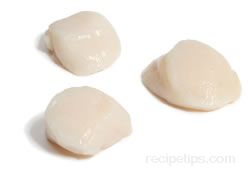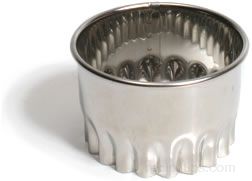Scallops are available in three varieties: sea scallops, bay scallops or calico scallops. The sea scallops, which are most readily available in the Atlantic waters of the U.S., grow to a length of two inches in diameter, providing a tender meat that is slightly less sweet than the bay scallop. The bay scallop, which also comes from the Atlantic grows to about one half inch in diameter and is harder to find but is tenderer and a little sweeter tasting than sea or calico scallops. The waters of the Gulf of Mexico produce the calico scallops are generally less than a half inch in diameter and may be sold as a bay scallop, since they look similar. Calico scallops are not as flavorful or as sweet as the bay or sea scallops. Scallops can be prepared using a variety of methods, such as broiling, baking and grilling.
When selecting, if possible choose scallops that are ivory colored or have a pinkish tone to their appearance, since they have not been bleached with a whitener or preservatives as have the brighter white colored scallops. The sweeter flavor of the scallop is attributed to their higher levels of producing glycogen. When the scallop is advertised as a "dry" or "untreated" scallop, it refers to the fresh scallops that do not have chemicals added such as preservatives, to make them last longer in stores. When scallops contain preservatives such as tripolyphosphate, they absorb water giving them a heavier weight of which water becomes 20% to 40% of their weight. Scallops containing preservatives are known as "treated" scallops and due to their higher water content, they may not brown or caramelize as well as "untreated" scallops.
To prepare scallops, begin by removing the muscles on each side of the scallop, if they have not already been cut away. If there are many different sized scallops, cut them crosswise to make them somewhat even in thickness. Simply cooking methods, if the scallops are not to be prepared in a seafood dish include sautéing, steaming or oven baking. To sauté, place the scallops in a sauté pan containing several tablespoons of butter and several tablespoons of olive oil. Sauté the scallops on high heat until evenly opaque halfway through the bottom or cooking side and then turn them over to do the same to the opposite side. This will typically take 4 to 12 minutes, depending on heat and size of the scallops. To steam, fill a cooking pot half full with water or if using a steamer pot fill with an inch of water. Add several teaspoons of olive oil or vegetable oil to dish or plate and coat the scallops evenly. Place the scallops in the boiling water or on the steamer basket above the boiling water and allow to cook for 3 to 10 minutes depending on size, until the meat becomes opaque and tender throughout. To oven bake, preheat the oven to 400ºF. Place the scallops on an ungreased baking sheet evenly separated. When the scallops begin to become golden tan to brown around the outer edge or the baking sheet has a similar brown ring forming around the scallop, they have completed cooking, which is typically 9 to 12 minutes.











